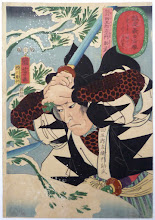I've spent quite a bit of time in the past couple years designing some versions of AD&D classes for use with Classic D&D that I'm happy with and think play well with the others. I've got a Barbarian, Bard, Cavalier (Paladin), Druid, Illusionist, Ranger, and Half-Orc in addition to the standard 7 (which have some house rules attached to them to a greater or lesser extent).
When I first started up this blog I was often blogging about them, but I lost steam somewhere around the time I'd gotten past the classic 4 character classes.
I think it's partially because in the back of my mind, I've realized that these extra classes are sort of pointless.
Sure, the Cavalier allows a Fighter type to cast some Cleric spells, Druid allows the Mentzer Druid spells to be availabe, Illusionist allows some AD&D illusion spells to be ported over, Half-Orc works as a Fighter/Thief or Assassin stand-in, etc.
But maybe I don't really need all that.
Give any character with a high Int and Cha a musical instrument and they can be a Bard. Give any character woodscraft and they can be a Ranger. A Barbarian is just a character from a more primitive area than the main campaign focus.
I'm sure you've heard it all argued before on Dragonsfoot, Knights and Knaves Alehouse, or some other FRPG website.
Anyway, I think I'm gonna scrap those extra classes as player options (at least at first) and only use them as NPCs from time to time.
Back when we were trying to get the Korean gals to play D&D, they really got in the way. Too many choices, and they had no real way to judge them. It also leads to the line of thinking among a lot of players a few years younger than me who think everything should have an effect on your character sheet.
Back in the day, we used to just roleplay out differences. My main character, Gwydion, was a Fighter who I modeled after a knight. Heavy armor, two handed sword, war horse (later griffon) and lance. My best friend, who goes by the internet alias KillingMachine, had two of his secondary characters named after the protagonists of the cheesy 80's swords & boobies B-movie "The Barbarians" but mechanically they were no different from Gwydion. They were just roleplayed as barbarians, and we rolled with it.
That's what I think I need to bring back to my games to make me happy. Players can be anything they want through roleplay, as long as they use one of the 7 basic classes for game mechanics.
Friday Fantasy: Return of the Green Death
5 hours ago






Absolutely. And don't be afraid to let them change the descriptions of their class a bit either, as long as the rules stay the same (or are something equivalent.) All the variety you could want is pretty much there already... no need to force in all the AD&D stuff.
ReplyDeleteRemember, adding a paladin class is like saying you *can't* play your fighter as a paladin.
I both agree and disagree. Stuff on your character sheet is generally important, since it points to what is most important in your game. If I wasn't waking up, I'd elaborate on it more, but look up the articles called Things on Character Sheets by lumpley games (the guy who made Dogs in the Vineyard) for a coherent take on what I'm trying to say ;)
ReplyDeleteI see what you're getting at--this works if you are, true to OD&D, playing a very free-form and rules-light sort of game where things are adaptable. In more rules-heavy games, mechanical options become more and more important in fusing the engine to the world.
ReplyDeleteHa, I'd almost forgot about those guys! We sure did have a fair share of secondary characters back in the day.
ReplyDeleteOne fairly simple thing we liked to use that seemed to help make the various characters different was unique basic gear and clothing.
"Fredlig", the gold plated wood cutters axe comes to mind. Stats wise, that thing was nothing but a basic axe(maybe even worse, can't remember), but it was one of the favored weapons of a character who was overloaded with various magical weapons and oddities.
I didn't remember that that axe had a name! It was just a plain old hand axe (1d6 dmg) though!
ReplyDelete@Nick--I agree that what's on the character sheet should tell you what's important about the game. But a lot of modern char sheets have so much minutia that ISN'T vital to the game. And players get hung up on that minutia and forget that there are times when you can use stuff that isn't written down.
@Dave--well, you know that's pretty much what I want out of RPGs these days. Loose frameworks with so many holes in the box that you can't help but think outside it.